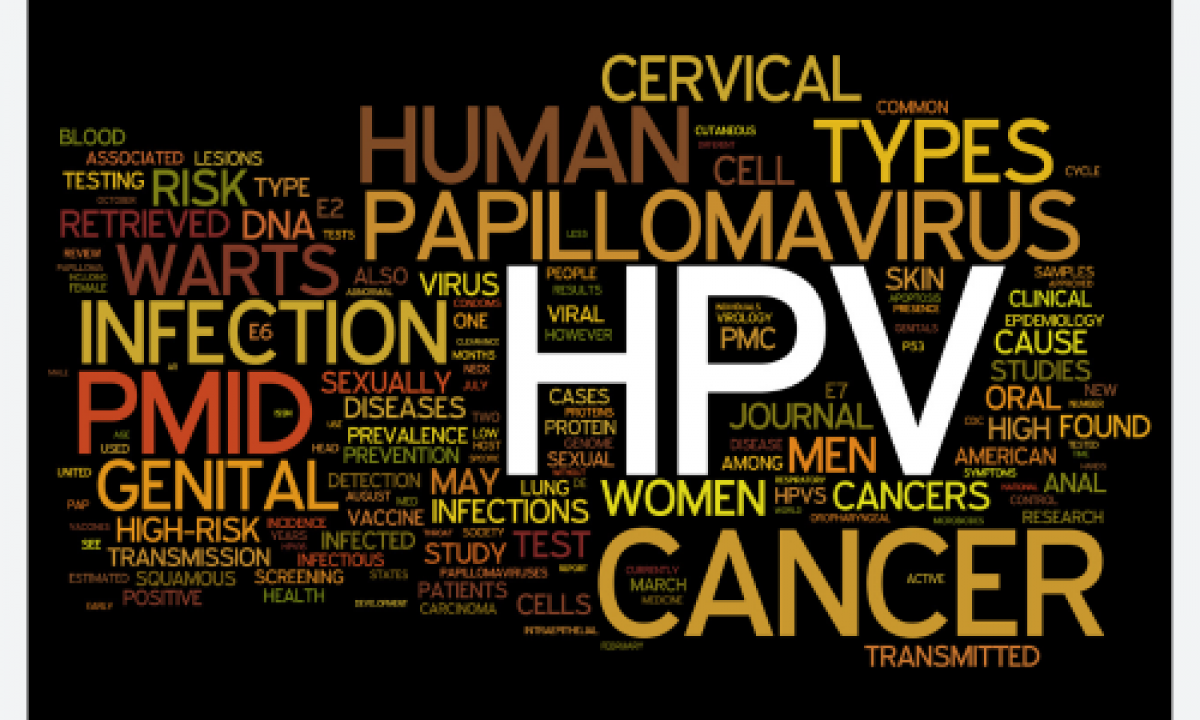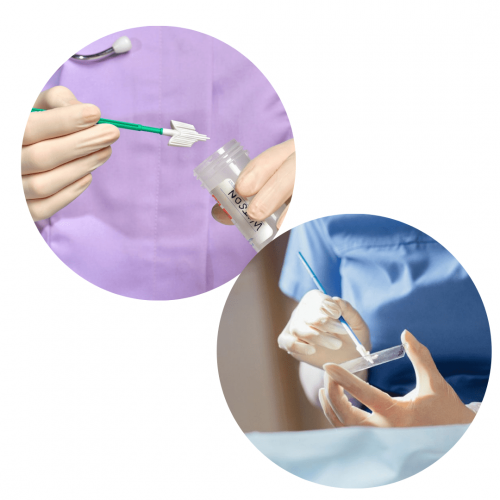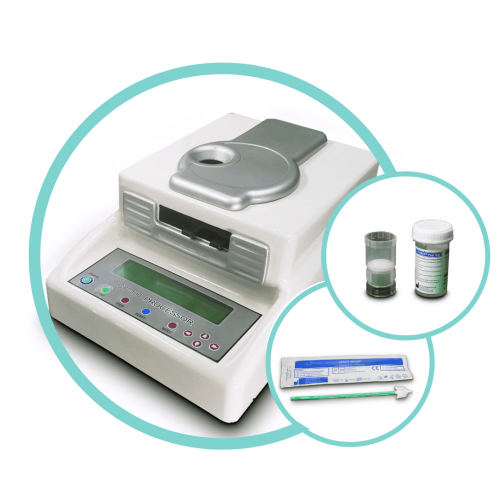Cervical cancer is one of the most common types of cancer occurring in women worldwide. This cancer is typically caused by infection with the Human Papilloma Virus (HPV). HPV is a family of DNA viruses with over 200 types that can infect humans. Some types of HPV, particularly high-risk types, can lead to cell changes that have the potential to become cancerous. In this article, we will discuss the specific types of HPV that are associated with two types of cervical cancer: adenocarcinoma and adenosquamous carcinoma.
Adenocarcinoma and Adenosquamous Carcinoma: Introduction Adenocarcinoma: This type of cancer originates in the glandular cells that produce mucus. It typically occurs in the inner part of the cervix, around the cervical canal.
Adenosquamous Carcinoma: This cancer is a mixture of squamous cells (flat cells) and glandular cells. It can occur in various parts of the cervix.
In a study conducted by Mastutik et al. (2021) titled "Distribution of Human Papilloma Virus (HPV) in Cervical Adenocarcinoma and Adenosquamous Carcinoma" published in Folia Medica Indonesiana, it is explained that based on histopathological descriptions, there are three main types of cervical cancer: squamous cell carcinoma, adenocarcinoma, and adenosquamous carcinoma. The most common type of cervical cancer is squamous cell carcinoma (approximately 70-75%), with the remaining (about 20-25%) being adenocarcinoma and adenosquamous carcinoma. Both types of cervical cancer are rarely found, which is why guidelines for their management have not yet been established. However, their incidence is on the rise, including in 13 European countries, as well as in the Netherlands. They predominantly affect young women, typically between the ages of 25-39 years. Some studies indicate that the prognosis for these two types of cancer is worse than that for squamous cell carcinoma, underscoring the importance of early detection and histopathological diagnosis as a basis for determining the appropriate therapeutic approach for these types of cancer.
The primary cause of adenocarcinoma and adenosquamous carcinoma cervical cancer is infection with the Human Papillomavirus (HPV). There are two groups of HPV: high-risk and low-risk. High-risk HPV is associated with the development of cervical cancer, while low-risk HPV is linked to benign warts on the oral epithelium and urogenital tract in both adults and children. However, some studies suggest that this type of cancer can also be caused by other factors, such as gene mutations or other factors, highlighting the necessity of identifying the HPV type as a basis for determining appropriate prevention and therapy. Identifying the type of HPV is beneficial in providing recommendations for selecting the appropriate vaccine to prevent cervical cancer.
This research was conducted at the Department of Anatomy Pathology, Dr. Soetomo Regional General Hospital in Surabaya from January to December 2015. Paraffin blocks from cervical adenocarcinoma and adenosquamous carcinoma tissue were used for the analysis of 40 types of HPV, including high-risk and low-risk HPVs: HPV 6, 11, 16, 18, 26, 31, 33, 35, 39, 40, 42, 43, 44, 45, 51, 52, 53, 54, 55, 56, 58, 59, 61, 62, 64, 66, 67, 68a, 68b, 69, 70, 71, 72, 73, 81, 82, 83, 84, 87, 89, and 90.
The study found that all specimens of cervical cancer tissue were positive for HPV infection. This indicates that in this study, all cases of cervical cancer were caused by HPV infection. The HPV types in cervical adenocarcinoma were HPV 6, 11, 16, 18, 31, 45, 68B, 72, and in adenosquamous carcinoma were HPV 6, 16, 18, 45, 59.
HPV 18 was found in 13 out of 22 (59.1%) cases of adenocarcinoma and in 19 out of 22 (86.4%) cases of adenosquamous carcinoma. HPV 18 is the most commonly found type in cervical adenocarcinoma, which is consistent with research conducted in other locations such as China, Thailand, and Japan.
This research also found the prevalence of HPV in cervical adenocarcinoma and adenosquamous carcinoma. High-risk HPVs included HPV 18 (67.3%), HPV 45 (5.5%), HPV 16 (3.6%), while low-risk HPVs included HPV 11 (10.9%) and HPV 6 (5.5%). These results align with our previous study, which identified the most common HPV types in preinvasive and invasive cervical cancer as HPV 16, HPV 18, HPV 45, HPV 52, and HPV 67. Other researchers in Indonesia have found that the most prevalent HPV types in Jakarta are HPV 16, 18, 52; in Bandung, they are HPV 16, 18, 45, 52. Additionally, a study of pap smear specimens in Jakarta, Tasikmalaya, and Bali showed that the most frequently encountered types were HPV 52, 16, 18, and 39. The most common HPV types in cervical cancer in Asia are HPV 16, 18, 58, 33, and 52, with HPV 52 and 58 being specific to Asia.
These findings indicate that the most commonly found HPV in cervical adenocarcinoma and adenosquamous carcinoma is HPV 18. In general, the most common high-risk HPVs are HPV 18, HPV 45, and HPV 16, while the most common low-risk HPVs are HPV 11 and HPV 6.
How to prefent the cervical cancer?
To prevent cervical cancer, here are some tips to follow:
- HPV Vaccination: Getting an HPV vaccination is the primary step in preventing cervical cancer. HPV vaccines provide protection against specific types of viruses most commonly associated with cervical cancer, including HPV 16 and 18.
- Pap Smear and HPV Test: Routinely undergoing Pap smears or HPV tests is an effective way to detect pre-cancerous cell changes or cancerous cells in the cervix at an early stage. Early detection allows for intervention before the condition worsens.
-
For PAP Smear examination, PT Isotekindo Intertama is a distributor of the CY-PREP™ CY-100 Processor, a cervical pre-cancer cytology product that employs the highly accurate Liquid-Based Cytology (LBC) method. The CY-PREP™ CY-100 Processor offers the following products:
A. Sampling using CY-PREP™ Pap Test CERVIX-BRUM®
Benefits:
- The sampling device is sterile, specially packaged for patient safety, and designed to collect samples from both the endo and ectocervical regions simultaneously.
- Designed to streamline the sampling process and reduce discomfort during sampling.
B. Liquid media for containing, transporting, and preserving test samples using CY-PREP™ Pap Test Preservation Solution
Benefits:
- Safeguards the sample, allowing it to be stored for up to 3 weeks at room temperature (15-30 °C). This prevents samples from drying out or getting damaged.
- Minimizes the risk of crucial samples being left in the sampling device.
- Ensures the collection of all cervical samples, enabling a comprehensive examination of all sample cells.
- Provides an ample amount of test samples, eliminating the need for patients to undergo additional sampling for follow-up tests.
C. Separation of the target material for inspection from impurities and debris using a dual filter
Benefits:
- Creates a thin layer of preparation, enhancing visibility during examination.
- Ensures that cells are more distinct as the cell staining process becomes more precise and adheres better.
D. Glass slides for attaching the samples using IHC link glass slides
Benefits:
- Creates a thin layer of preparation, improving visibility during examination.
- Ensures that cells are more distinct as the cell staining process becomes more precise and adheres better.
-
- Regular Gynecological Examinations: Having regular check-ups with an obstetrician or gynecologist is crucial for monitoring reproductive health. Doctors can provide advice and recommendations based on individual health history and risk factors.
- Practice Safe Sex: Using condoms during sexual intercourse can help reduce the risk of HPV transmission and other infections associated with cervical cancer.
- Avoid Smoking: Smoking is linked to an increased risk of cervical cancer. Therefore, quitting smoking or refraining from starting is a crucial step in prevention.
- Maintain a Healthy Sexual Life: Limiting the number of sexual partners and choosing partners who also practice safe sexual behavior can help reduce the risk of exposure to HPV and other infections.
- Importance of Balanced Nutrition: Having a healthy diet that includes plenty of fruits, vegetables, whole grains, and lean proteins can help strengthen the immune system and support reproductive health.
- Manage Stress: Chronic stress can affect the immune system. Finding ways to manage stress such as meditation, yoga, or exercise can help maintain overall health.
- Education and Self-awareness: Knowing about risk factors, early symptoms, and prevention methods for cervical cancer is a crucial step in ensuring optimal reproductive health.
- Regular Consultations with a Doctor: Speaking regularly with an obstetrician or gynecologist about reproductive health and undergoing recommended examinations is a key step in preventing cervical cancer.
It's important to remember that a combination of the above factors can provide the best protection. Always consult with a doctor for recommendations and advice that are tailored to your individual needs.
References:
-
- Bosch, F. X., Lorincz, A., Munoz, N., Meijer, C. J., & Shah, K. V. (2002). The causal relation between human papillomavirus and cervical cancer. Journal of Clinical Pathology, 55(4), 244-265.
- Doorbar, J., Quint, W., Banks, L., Bravo, I. G., Stoler, M., Broker, T. R., & Stanley, M. A. (2012). The biology and life-cycle of human papillomaviruses. Vaccine, 30, F55-F70.
- Insert Pack CY-PREP™ CY-100 Processor
- Mastutik, G., Rahniayu, A., Kurniasari, N., Rahaju, A. S., & Harjanto, B. (2021). Distribution of Human Papilloma Virus (HPV) in Cervical Adenocarcinoma and Adenosquamous Carcinoma. Folia Medica Indonesiana, 57(2), 170–176.







